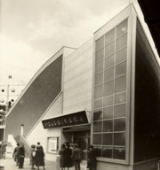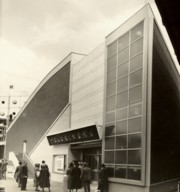
Telekinema
Encyclopedia

Festival of Britain
The Festival of Britain was a national exhibition in Britain in the summer of 1951. It was organised by the government to give Britons a feeling of recovery in the aftermath of war and to promote good quality design in the rebuilding of British towns and cities. The Festival's centrepiece was in...
's London South Bank Exhibition in the summer of 1951. It was situated between Waterloo Station
Waterloo station
Waterloo station, also known as London Waterloo, is a central London railway terminus and London Underground complex. The station is owned and operated by Network Rail and is close to the South Bank of the River Thames, and in Travelcard Zone 1....
and the Royal Festival Hall
Royal Festival Hall
The Royal Festival Hall is a 2,900-seat concert, dance and talks venue within Southbank Centre in London. It is situated on the South Bank of the River Thames, not far from Hungerford Bridge. It is a Grade I listed building - the first post-war building to become so protected...
.
The Telecinema (or Telekinema) was the first cinema in the world specially designed and built to show both films and television.. It was designed by Wells Coates
Wells Coates
Wells Wintemute Coates OBE was an architect, designer and writer. He was, for most of his life, an ex-patriate Canadian architect who is best known for his work in England...
. Although the Festival literature and British Film Institute
British Film Institute
The British Film Institute is a charitable organisation established by Royal Charter to:-Cinemas:The BFI runs the BFI Southbank and IMAX theatre, both located on the south bank of the River Thames in London...
press releases called it the "Telecinema", the name on the outside of the building was "Telekinema".
The Programme and presentation were by J.D. Ralph and R.J. Spottiswoode. The Telecinema created a heightened sense of realism by special effects that involved the audience more closely in what was shown. Among the techniques employed were a borderless screen and film with multiple sound tracks whose sound was reproduced through a series of loudspeakers behind the screen and in the auditorium - an early use of stereophonic sound. It proved one of the most popular attractions of the Festival, showcasing one feature film, fourteen documentaries, four experimental films and four 'stereoscopic' (3-D) films. It was operated and programmed by the British Film Institute
British Film Institute
The British Film Institute is a charitable organisation established by Royal Charter to:-Cinemas:The BFI runs the BFI Southbank and IMAX theatre, both located on the south bank of the River Thames in London...
. In October 1952, a year after the closure of the Festival, it re-opened as the National Film Theatre (NFT). It remained until 1957, when the NFT relocated to a cinema under Waterloo Bridge.

